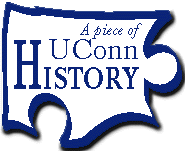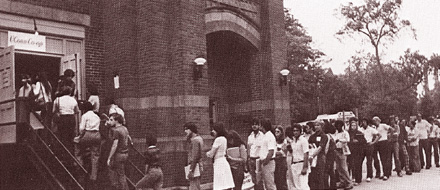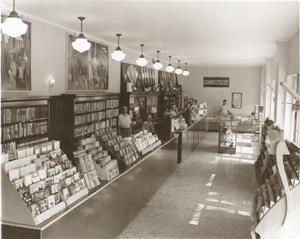|
This is an archived article.
For the latest news, go to the
Advance Homepage For more archives, go to the Advance Archive/Search Page. 
| |||||||||
In the 1880s and 1890s, the earliest students of Storrs Agricultural School bought their books, pencils and paper from faculty members, who ordered the materials from suppliers and sold them at cost. It was in 1900 that a bookstore began, located in the Old Main Building that also housed classrooms, laboratories, administrative offices, apartments for faculty, a museum of natural history, and a library. Old Main was located where the flagpole now stands, between Beach Hall and the Waring Building.
The bookstore of 1900 was operated from the library. Edwina Whitney - campus librarian from 1900 to 1934, for whom Whitney Hall is named - sold textbooks, stationery and school supplies to students. Whitney would serve as the store clerk for one hour each morning and afternoon. Sales at that time amounted to approximately $1,200 per year. Later the store was moved to a small room next to the library in Old Main and, around 1913, a student was employed for three to four hours per day. Then in 1920, space became available in the basement of Old Main - an area formerly occupied by the woodworking department - and the bookstore was moved, a soda fountain installed and the line of goods expanded. The move was reported in the October 2, 1920, issue of The Connecticut Campus, with the soda fountain cited as a main feature of the new site. College catalogs from 1884 to 1916 say that texts, stationery and supplies were bought by faculty "at a reduced rate and sold to students at cost." The 1917 catalog adds that the bookstore - even with its soda fountain - "is not run for profit." By 1920, according to the catalog, the store was "a cooperative student store which handles principally stationery, textbooks, athletic goods, college emblems, and the usual student supplies. Profits which arise from this store are devoted to defraying expenses incident to coaching and training student athletic teams."
A Home in Beach Hall
In 1933, all profits from the bookstore were put into what was called a "Revolving Fund." The report of a committee appointed in 1937 to investigate bookstore operations said that this arrangement "made it possible for the net profits from the operations of the bookstore to be kept by the college rather than revert to the state." The report, submitted to President Albert N. Jorgensen on May 2, 1938, indicated that between 1923 and 1926, the average annual sales of the bookstore were $36,351; from 1934 to 1937, the average sales were $43,566. The bookstore, committee members found, had paid yearly rent only once during the period from 1923 to 1937, in 1935. The committee appointed by Jorgensen recommended two goals for the bookstore: operate as a service to students; and publicize operations and profits "in order to minimize criticism of the store." It was also recommended that a permanent manager be hired to run the store, that it be operated at no profit, and that no rent or utilities be charged by the college. College controller Raymond I. Longley opposed some of the committee's recommendations, particularly one that called for a student and faculty member to act as advisors to the store manager. He also questioned a recommendation on how much to charge for books and supplies, telling President Jorgensen in a letter that "if put in effect, this will mean a loss of several hundred dollars a year." It's not clear whether Longley's concerns were assuaged, but complaints about textbook prices have been a recurring issue.
The Move to Dog Lane A later addition to the building housed the Storrs Post Office, and plans were in the works to include a grocery store, barber shop, beauty parlor, and sales of UConn farm products. But the site was deemed too small, and those facilities were included in a commercial block built in the mid-1950s, the same block that today includes Store24, Husky Blues and Paul's Pizza. In its new facilities, the bookstore again had a soda fountain, and added a snack bar. But those didn't last long. The store needed more space for books as the post-war student population exploded and, as other facilities came along, such as the Student Union in the early 1950s, the fountain and snack bar were removed. With an addition to the Student Union Building in the early 1960s known as the Commons Building, the bookstore moved out of its Route 195 location (the building today houses University Communications) and into the basement of the Commons.
For-Profit Experiment
Follet closed its doors on March 3, 1975. The new cooperative began with the book-buyback in April of 1975, operating out of the Commons Building. The current Co-op building opened its doors in 1980. The Co-op now has a board of directors comprised of elected students, faculty and staff. It operates stores at regional campuses and the School of Law and, since 1995-96, has operated the Husky II Shop in the Hartford Civic Center. The most recent additions to the Co-op's operations are the Husky Direct Catalog and online Husky Shop. Mark J. Roy SOURCES: Correspondence and papers of Albert N. Jorgensen, various issues of the Connecticut Campus and Nutmeg Yearbook. These an other materials on the history of the University are in the University Archives at the Thomas J. Dodd Research Center. |

 he University has had a bookstore
providing students with textbooks
and supplies for 99 years - sometimes as a profit-making operation,
and sometimes as a cooperative.
he University has had a bookstore
providing students with textbooks
and supplies for 99 years - sometimes as a profit-making operation,
and sometimes as a cooperative. 


